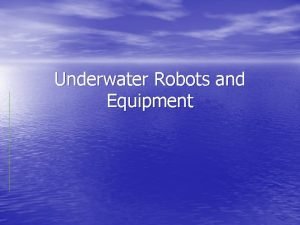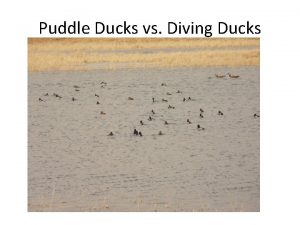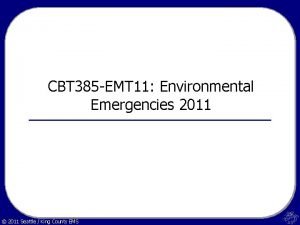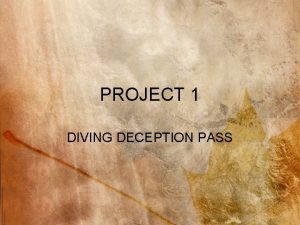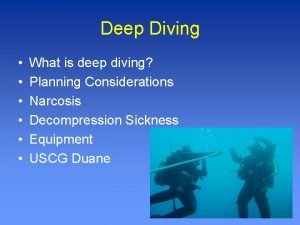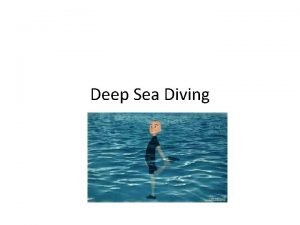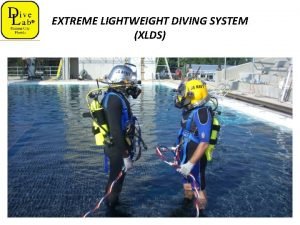PROJECT 1 DIVING DECEPTION PASS Deception Pass is















![That’s means that somewhere in the interval of [-300, 300] the direction of flow That’s means that somewhere in the interval of [-300, 300] the direction of flow](https://slidetodoc.com/presentation_image_h2/058394d3b4cf43f9f654994b990515bb/image-16.jpg)

- Slides: 17

PROJECT 1 DIVING DECEPTION PASS

• Deception Pass is a narrow channel between two large islands near Seattle, Washington. There is a bridge across the channel that connects the two islands. When the tide comes in, the entire Pacific Ocean pushes water throw that channel to get to the inner part of the Puget sound.

EQUATIONS

PROBLEM 1 • Suppose that the velocity V 0 of the current under the bridge is 7 mph. Convert V 0 to feet per second, and then find the Velocity of the current 600 feet to the west of the bridge. Likewise find the velocity of the current 200 feet east of the bridge, and 800 feet east of the bridge.

SOLUTION 1 Case III

PROBLEM 2 • Under the assumptions of Problem 1, where is the current faster?

SOLUTION 2

PROBLEM 3 (CD) • You will learn how to solve differential equations such as (1) in Chapter 2. For the moment, use the Deception Pass Tool on the DE Tools CD to see how your motions changes depending on where you start. In words, describe your motion if you enter the channel 1000 feet west of the bridge. Describe your motion if you enter 1000 feet east of the bridge.

SOLUTON 3 • We can see that there is acceleration in the motion until it reaches a maximum speed of 10. 27 ft/sec, then the motion starts to decelerate.

PRPBLEM 4 • Suppose that the time t=0 corresponds to slack water. Compute the velocity of the current near your entry point 1000 feet west of the bridge, that is, with x = -1000, when you started your dive one hour after slack water. Remember that time is given in seconds.

SOLUTION 4

PROBLEM 5 • You want to compute your likely position relative to the bridge from the time you entered the water (exactly 1 hour after slack water, at a point 1000 feet west of the bridge). What initial-value problem would you solve to do so?

SOLUTION 5

PROBLEM 6 • Show that the model (5) gives opposite signs for the velocity of the current at x = -300 and x = 300. What does this mean Physically? Discuss the physical validity of this DE in view of the sign of the channel-size function S(x).

SOLUTION 6 Case I (x= - 300) Case II (x= 300)
![Thats means that somewhere in the interval of 300 300 the direction of flow That’s means that somewhere in the interval of [-300, 300] the direction of flow](https://slidetodoc.com/presentation_image_h2/058394d3b4cf43f9f654994b990515bb/image-16.jpg)
That’s means that somewhere in the interval of [-300, 300] the direction of flow will be reversed by it self which is impossible. That means that the channel-size function is not valid

Thank You Muchas Gracias
 Deception pass proposal
Deception pass proposal Maiden of deception pass
Maiden of deception pass Thematic statement structure
Thematic statement structure Much ado about nothing motifs
Much ado about nothing motifs Macbeth suffering
Macbeth suffering The art of deception by kevin mitnick
The art of deception by kevin mitnick Passive deception
Passive deception Active vs passive deception
Active vs passive deception Deceit in jane eyre
Deceit in jane eyre Fidelis deception
Fidelis deception Ushmm
Ushmm Appearance vs reality in hamlet
Appearance vs reality in hamlet Deception in a sentence
Deception in a sentence Ddo a lesson in deception
Ddo a lesson in deception Atmospheric suits
Atmospheric suits What is one characteristic of puddle ducks?
What is one characteristic of puddle ducks? Kelly goudreau
Kelly goudreau Emt environmental
Emt environmental














